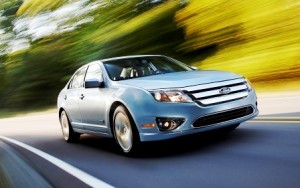
Shortages of Japanese-made components, such as semiconductors and batteries, could bring trouble for U.S. makers, including Ford, which uses Japanese batteries in its Fusion Hybrid.
While the Japanese auto industry reels from the devastating one-two-three punch of earthquake, tsunami and multiple nuclear accidents, domestic carmakers are also growing increasingly anxious about the global reach of the catastrophe.
Officials from General Motors, Ford Motor Co. and Chrysler Group report they are monitoring the situation carefully – while also exploring the potential for alternate sourcing of components currently purchased from Japan.
The lack of a single key component could bring an assembly plant to a sudden halt, industry insiders fear.
“One area of growing concern is the supply of automotive semiconductors,” noted analyst Rod Lache, of Deutsche Bank. “Auto Industry purchasing execs had already expressed concern about tight supply of Auto Semis even prior to the disaster.”
These are the central components of today’s digital automotive componentry, whether used in engine management systems, airbag controllers or an infotainment like Ford’s Sync. Japan, said Lache, produces about 22% of global auto semiconductors. But the production process is particularly sensitive, and “even millisecond (electric) outages or small tremblers can result in the scrapping of weeks of in-process production.”
There’s also the issue of battery production, another area dominated by Japanese suppliers.
Ford Motor Co. is carefully monitoring the situation surrounding battery cells used in its hybrid vehicles such as the Ford Escape and Ford Fusion. Sanyo, a Japanese electronics company, makes the cells for Ford.
General Motors spokesman Tom Wilkinson also confirmed GM depends on components from suppliers in Japan and is watching the situation carefully.
Chrysler spokeswoman Katie Hepler said the automaker was trying to determine if the disruption created by the quake could impact the company’s production in the U.S.
However, communications within Japan have been limited, according to Japanese officials.
GM and Ford reported all of their employees stationed in Japan have now been accounted for. Ford officials, however, reported that the company’s dealership in Sendai, near the epicenter of the earthquake was seriously damaged.
“The exact impact of the earthquake and tsunami is still being assessed in terms of preliminary damage estimates, with work ongoing by the automakers, suppliers, government parties, and rescue agencies even at the time of writing,” noted IHS Global Insight in report Monday.
However, Global Insight reported Toyota will idle all of its facilities in Japan from 14 to 16 March, with the loss of 40,000 units of production, but it is particularly concerned about two subsidiary facilities close to the Sendai region of Japan that make the Yaris subcompact and Scion-brand xD and xB models. Toyota’s Central Motor Corporation’s Miyagi plant.
Kanto Auto Works’ Iwate plant have been shuttered as the company assesses the situation in the heavily damaged region. Toyota says that it has accounted for all members of its plants and subsidiaries in the region.
Overall, nearly 45% of Toyota’s global production has been halted. The maker has estimated that every day its Japanese operations are shuttered will cut $72 million in profits.
Nissan says that several plants have reported damage in the wake of the earthquake. These include Iwaki Plant, Tochigi Plant, Yokohama Plant, Oppama Plant, Zama Operations Center, and Honmoku Wharf – all reporting at least some damage to buildings and/or equipment.
The company is suspending all Japanese production operations through Wednesday, though several factories won’t be up-and-running until at least Friday. The company plans to further assess its ability to resume production later this week.
Nissan has also reported damage to 1,300 United States-bound vehicles at the Port of Hitachi in Ibaraki Prefecture and damage to 1,000 vehicles stored at the Miyagi Service Centrer (Tagajo City, Miyagi Prefecture) due to the tsunami.
Global Insight also reported Honda has closed its Tochigi research and development facility north of Tokyo after it idled several plants through March 20. The Tochigi engine, transmission, and chassis parts plant has been shut, as well as two plants in Saitama: the Sayama plant, which produces the CR-V, Accord, US Fit, Acura RL, and TSX; and the Ogawa Plant, which produces vehicle engines. In addition, two plants in Hamamatsu have been closed—one for vehicle transmissions, and one for outboard marine engines.
Suzuki has closed all of its plants in Japan from March 14 to 17, after which the company will assess the situation. The closures affect the Takatsuka plant, which assembles motorcycle engines; the Kosai passenger car assembly plant; the Iwata multi-purpose vehicle and commercial vehicle assembly plant; the Toyokawa motorcycle and outboard motor assembly plant; the Sagara passenger car and engine assembly plant; and the Osuka plant foundry.
Meanwhile, the situation inside Japan remains conflicted. On the one hand the Japanese government as encouraged business to restart but on the other, Japan’s all-powerful, Ministry of Economy, Trade and Industry’s has ordered electricity conservation efforts and rolling blackouts to ensure the ongoing rescue efforts have ample electricity.
Japanese airports are reportedly overwhelmed by those trying to leave the country. Industry sources say at least some foreign automakers and suppliers are encouraging, even ordering foreign nationals to leave Japan.
So far, Detroit makers say they have not chosen to take similar steps and will leave employees on the ground.
Nissan has sent home visiting employees, according to spokesman Simon Sproule, and has given both “expats” and domestic employees the option of leaving. The company is also permitting employees to take time, if necessary, to move family to safer locations, away from the quake zone and areas being evacuated because of radiation concerns.
But of nearly a dozen senior U.S. and European employees, including Sproule, “none of us are leaving,” said the executive, who heads global marketing and communications.
Paul A. Eisenstein contributed to this report.

Come on General Motors, Ford and Chrysler, time to bring that work back here to the US and put Americans back to work.